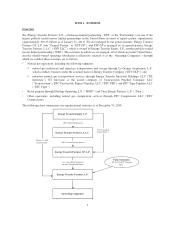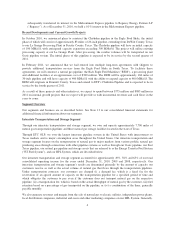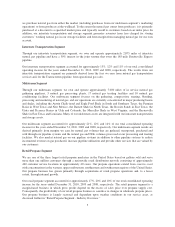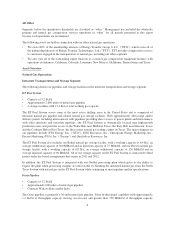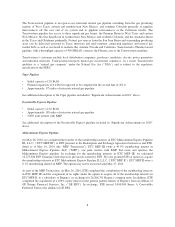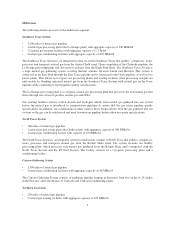Energy Transfer 2010 Annual Report Download - page 14
Download and view the complete annual report
Please find page 14 of the 2010 Energy Transfer annual report below. You can navigate through the pages in the report by either clicking on the pages listed below, or by using the keyword search tool below to find specific information within the annual report.
Maintain low-cost, decentralized operations.We focus on controlling costs, and we attribute our low overhead
costs primarily to our decentralized structure.
Natural Gas Operations Segments
Industry Overview
The midstream natural gas industry is the link between the exploration and production of natural gas and the
delivery of its components to end-use markets. The midstream industry consists of natural gas gathering,
compression, treating, processing and transportation and NGL fractionation and transportation, and is generally
characterized by regional competition based on the proximity of gathering systems and processing plants to
natural gas producing wells.
Natural gas has widely varying quality and composition, depending on the field, the formation or the reservoir
from which it is produced. The principal constituents of natural gas are methane and ethane, though most natural
gas also contains varying amounts of heavier components, such as propane, butane and natural gasoline that may
be removed by a number of processing methods. Most raw materials produced at the wellhead are not suitable for
long-haul pipeline transportation or commercial use and must be compressed, transported via pipeline to a central
processing facility, and then processed to remove the heavier hydrocarbon components and other contaminants
that would interfere with pipeline transportation or the end use of the gas.
Demand for natural gas.Natural gas continues to be a critical component of energy consumption in the United
States. According to data released in December 2010 by the Energy Information Administration, total domestic
consumption of natural gas is expected to rise to 26.5 Tcf in 2035 compared to 2009 consumption of 22.7 Tcf.
The industrial and electricity generation sectors currently account for more than half of natural gas usage in the
United States.
Natural gas gathering. The natural gas gathering process begins with the drilling of wells into gas-bearing rock
formations. Once a well has been completed, the well is connected to a gathering system. Gathering systems
generally consist of a network of small diameter pipelines and, if necessary, compression systems, that collect
natural gas from points near producing wells and transport it to larger pipelines for further transportation.
Natural gas compression.Gathering systems are operated at design pressures that will maximize the total
throughput from all connected wells. Specifically, lower pressure gathering systems allow wells, which produce
at progressively lower field pressures as they age, to remain connected to gathering systems and to continue to
produce for longer periods of time. As the pressure of a well declines, it becomes increasingly difficult to deliver
the remaining production in the ground against a higher pressure that exists in the connecting gathering system.
Field compression is typically used to lower the pressure of a gathering system. If field compression is not
installed, then the remaining production in the ground will not be produced because it cannot overcome the
higher gathering system pressure. In contrast, if field compression is installed, then a well can continue
delivering production that otherwise might not be produced.
Natural gas treating.Natural gas has a varied composition depending on the field, the formation and the
reservoir from which it is produced. Natural gas from certain formations is higher in carbon dioxide, hydrogen
sulfide or certain other contaminants. Treating plants remove carbon dioxide and hydrogen sulfide from natural
gas to ensure that it meets pipeline quality specifications.
Natural gas processing.Some natural gas produced by a well does not meet the pipeline quality specifications
established by downstream pipelines or is not suitable for commercial use and must be processed to remove the
mixed NGL stream. In addition, some natural gas produced by a well, while not required to be processed, can be
processed to take advantage of favorable processing margins. Natural gas processing involves the separation of
natural gas into pipeline quality natural gas, or residue gas, and a mixed NGL stream.
12


